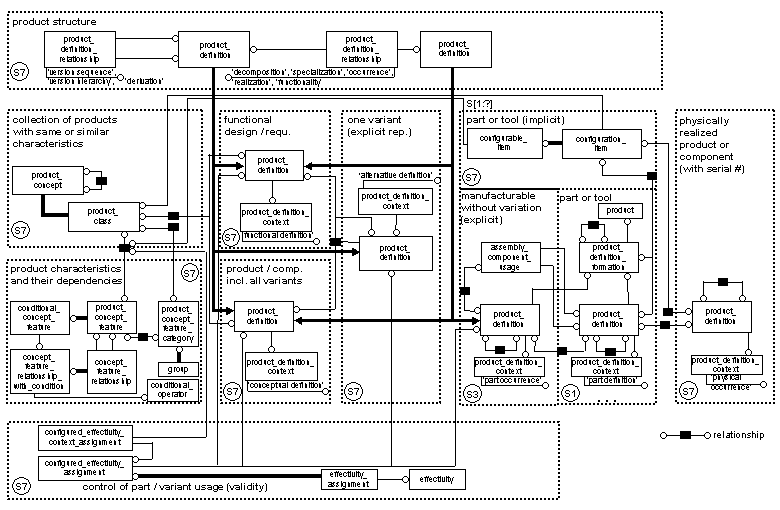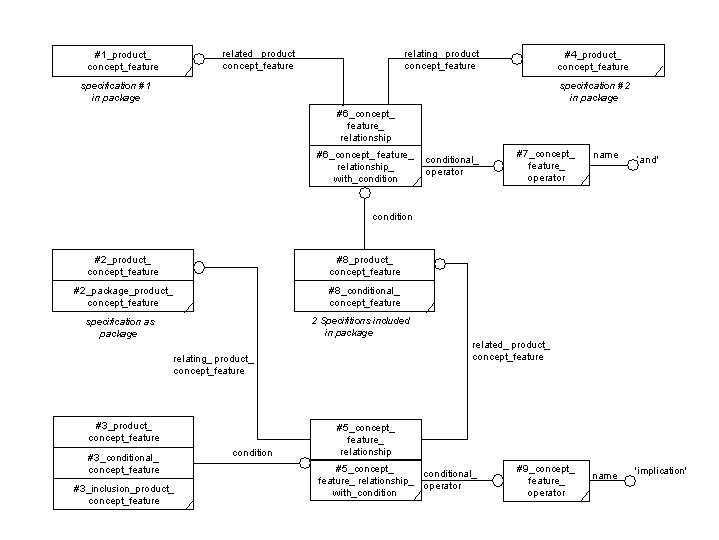-
product_class is used to identify a set of similar products to be offered to the market;
A product_class is a product_concept and a characterized_object.
The characterized_object may have property_definition entities associated to it through property_definition.definition and
the select type characterized_definition.
The instances of product_class may build a hierarchical tree-like structure through instances of product_concept_relationship
that have the attribute name set to 'hierarchy' and that reference with the attribute related_product_concept the product_class
that is a subclass of the product_class referenced by the attribute relating_product_concept.
NOTE 1
Since the market context information is not needed from an ARM perspective or would be represented using an particular product_concept_feature,
the mandatory attribute market_context points to an entity product_concept_context with:
- - attribute market_segment_type ='/NULL'
-
- inherited attribute application_context_element.name = '/NULL'
-
product_concept_feature is used to describe a characteristic of the products within a product_class.
The product_concept_feature is associated to a product_class through a product_concept_feature_association with the attribute
name set to 'replaceable standard', 'non replaceable standard', 'availability', 'identification', 'option', 'part usage',
or any other non standardized value.
For a definition of the meaning of the standardized values, see ARM definition of Class_specification_association.
package_product_concept_feature is a subtype of product_concept_feature that is used when the characteristic is in fact a set of other characteristics, for
example a package of several options for a passenger car.
In this case, there is an inclusion_product_concept_feature, a subtype of conditional_concept_feature, with the inherited
attribute condition referencing a concept_feature_relationship_with_condition with the attribute conditional_operator set
to 'implication'.
The inherited attribute relating_product_concept_feature of the concept_feature_relationship_with_condition references the
package_product_concept_feature, and the inherited attribute related_product_concept_feature references either the one product_concept_feature
that belongs to the package or another conditional_concept_feature that references the product_concept_feature instances of
the package through an 'and' operation.
Figure F.2 provides an example of package with two product_concept_feature.
Figure F.2 — Package of two specifications
-
product_concept_feature_category is used to group similar instances of product_concept_feature, like the different outside colour characteristics of the products.
A product_concept_feature_category is a group of instances of product_concept_feature.
Instances of product_concept_feature are assigned to their product_concept_feature_category through an instance of applied_group_assignment.
For this group_assignment, the attribute items references, through the select type group_item, instances of product_concept_feature
or package_product_concept_feature, the attribute assigned_group references product_concept_feature_category or exclusive_product_concept_feature_category,
the attribute role references object_role with the attribute name set to 'specification category member'.
exclusive_product_concept_feature_category is a subtype of product_concept_feature_category that is used when the members
of the group are mutually exclusive in their usage within a product.
EXAMPLE 3
An exclusive_product_concept_feature_category would be used if there is exactly one outside colour that can be chosen for
a particular product.
product_concept_feature_category is associated to product_class through product_concept_feature_category_usage that is subtype
of group_assignment.
For this group_assignment the attribute items references, through the select type category_usage_item, an instance of product_class,
the attribute assigned_group references product_concept_feature_category or exclusive_product_concept_feature_category, the
attribute role references object_role with the attribute name set to 'mandatory category usage' or 'optional category usage'.
For a definition of the meaning of the two values, see ARM definition of Class_category_association.
-
conditional_concept_feature is used to control the usage of a product classified as 'part' or 'tool' (by product_related_product_category) within the
products of a product_class and to represent global conditions for instances of a product_class.
The conditional_concept_feature is subtype of product_concept_feature.
The conditional_concept_feature is used to build up boolean conditions for instances of product_concept_feature.
The conditional_concept_feature references with its attribute condition a concept_feature_relationship_with_condition that
represents a binary boolean operation.
A concept_feature_relationship_with_condition is subtype of concept_feature_relationship with the attribute conditional_operator
pointing to a concept_feature_operator with the attribute name set to 'and', 'or', 'oneof', 'not', or 'implication'.
The intended usage of the unary 'not' operation is that the inherited attributes relating_product_concept_feature and related_product_concept_feature
reference the same instance of product_concept_feature.
The value 'implication' is only allowed, if the inclusion_product_concept_feature subtype of conditional_concept_feature is
used.
This is ensured by the rule restrict_concept_feature_operator.
For a definition of the meaning of the other values, see ARM definition of Specification_expression.
conditional_concept_feature may be associated to a product_class through product_concept_feature_association with the attribute
name set to 'part usage', 'identification', 'validity', 'design case', or any other non standardized value.
For a definition of the meaning of the standardized values, see ARM definition of Class_condition_association.
The value 'part usage', which is also applicable for the association of a product_concept_feature to a product_class, see
above, indicates that the conditional_concept_feature (or product_concept_feature) controls the usage of a part within a product
of the associated product_class.
In this case, the product_concept_feature_association is referenced by a configured_effectivity_context_assignment that is
a subtype of effectivity_context_assignment through the select type configured_effectivity_context_item.
-
product_definition that has a product_definition_context with the inherited attribute name set to 'functional definition'.
It is used to describe the functional requirements for the products or the components of the products of a product_class.
Such instances of product_definition for functional requirements may be related to instances of product_class through an instance
of configuration_design and configuration_item.
In this case the attribute name of configuration_design is set to 'functionality'.
For a definition of the meaning of the standardized value, see ARM definition of Class_breakdown_association.
-
product_definition that has a product_definition_context with the inherited attribute name set to 'conceptual definition'.
It is used to describe the common decomposition structure of all products of a product_class.
Such instances of product_definition for a common decomposition structure may be related to instances of product_class through
an instance of configuration_design and configuration_item.
In this case the attribute name of configuration_design is set to 'realization'.
For a definition of the meaning of the standardized value, see ARM definition of Class_breakdown_association.
-
product_definition that has a product_definition_context with the inherited attribute name set to 'alternative definition'.
It is used to describe a variant in the realization of a product_definition with context 'functional definition' or 'conceptual
definition'.
An instance of product_definition with context 'alternative definition' shall be associated to another product definition
where it is a variant of through an instance of product_definition_relationship with the attribute name set to 'solution alternative
definition'.
The related_product_definition points to the variant (with context 'alternative definition') and the relating_product_definition
references a product_definition with context 'functional definition', 'conceptual definition', or 'alternative definition'.
In the latter case, the product_definition instance with context 'alternative solution' defines a variant of another instance
of product_definition with context 'alternative solution', for example, where the first level defines technically different
solutions and the second level defines different suppliers for the same technical solution.
All instances of product_definition with context 'alternative definition' that are defined through this path as variant of
the same instance of product_definition are the mutually exclusive variants.
-
product_definition that has a product_definition_context with the inherited attribute name set to 'part occurrence'.
It is used to identify an occurrence of a component in an assembly structure, for example, to identify the component occurrences
of a product_definition with context 'alternative definition'.
A product_definition with context 'part occurrence' defines exactly one occurrence of a part within a given assembly structure.
An instance of product_definition with context 'part occurrence' may be defined as an element (as related_product_definition),
of a product_definition instance with context 'alternative solution' (as relating_product_definition), through a product_defininition_relationship
with the attribute name set to 'realization'.
A product_definition with context 'part occurrence' may also represent a component occurrence in an explicit product structure
defined by assembly_component_usage.
In this case it is linked to the assembly_component_usage by a product_definition_occurrence_relationship.
-
product_definition_usage with the attribute name set to 'decomposition', 'occurrence', 'realization', 'functionality', or 'specialization' is used
to define the structure for product_definition instances with context 'functional definition', 'conceptual definition', or
'alternative definition' as relating_product_definition.
The related_product_definition is an instance of product_definition with context 'functional definition', 'conceptual definition',
or 'part occurrence'.
With this tree-like decomposition structures for product_definition instances with the same context, attribute name set to
'decomposition', 'specialization', or 'occurrence' as well as relationships between product_definition_instances with different
context, attribute name set to 'realization' or 'functionality', can be defined.
For a detailed definition of the meaning of the standardized values for the attribute name of product_definition_relationship,
see ARM definition of Breakdown_node_relationship.
-
configured_effectivity_context_assignment and configured_effectivity_assignment are used to link a product_definition instance with context 'part occurrence', 'alternative definition', 'conceptual definition',
or 'functional definition' with the condition under which it is used or designed.
The configured_effectivity_context_assignment is a subtype of effectivity_context_assignment that references with its attribute
items, through the select type configured_effectivity_context_item, the product_concept_feature_association that defines the
usage case or condition.
The inherited attribute assigned_effectivity_assignment references the configured_effectivity_assignment instance.
configured_effectivity_assignment is a subtype of effectivity_assignment that references with its attribute items, through
the select type configured_effectivity_item, the product_definition with context 'part occurrence', 'alternative definition',
'conceptual definition', or 'functional definition' to which the usage case or condition applies.
The attribute role references an object_role instance with the attribute name set to 'design' or 'usage' and with the attribute
description set to 'inherited', 'local', or 'exception'.
For a definition of the meaning of the standardized values for the name attribute and for the description attribute, see ARM
definition of Configuration.
configured_effectivity_assignment references with its inherited attribute assigned_effectivity an instance of effectivity
with an id of 'configuration validity' to indicate the valid use of the item contained in the items attribute. dated_effectivity
or time_interval_based_effectivity instances may additionally be assigned to a configured_effectivity_assignment through applied_effectivity_assignment
instances to indicate the time range for which the configuration is valid.
-
product_identification and product_specification are used to identify a potentially manufacturable product selected among a product_class by its specific characteristics
(product_concept_feature instances), for example, a customer order for a passenger car.
Both these entities are subtypes of configuration_item.
They reference with their inherited attribute item_concept, the product_class of the manufacturable product.
The attribute item_concept_feature of product_specification points to a set of product_concept_feature_association instances
that define the specified characteristics of the manufacturable product.



